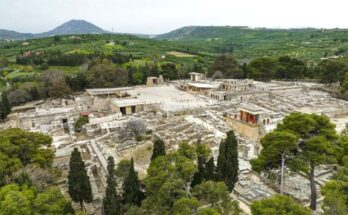
When the Roman Empire began collapsing in the 4th century AD, Christianity prevailed, and the Roman Catholic Church kept the fragmented territories together.
It was 381 AD when Christianity became the official religion of the former great empire. This tremendous historical change was mainly due to Emperor Theodosius the Great, the last emperor of the Roman Empire before it eventually split permanently into the Eastern Roman Empire and Western Roman Empire.
A devout Christian, Theodosius suppressed paganism and Arianism and signed the Edict of Thessalonica, establishing the Nicene Creed of the Council of Nicaea (325 AD) as the norm for Christian orthodoxy and directed the convening of the second general council at Constantinople (381) to clarify the formula.
The Christian religion, which was monotheistic, ran counter to the traditional Roman religion, which was polytheistic, influenced by the ancient Greek pantheon. It was an important change after the persecution of Christians by previous Roman emperors in the 1st century.
The fall of a mighty empire
The Roman Empire decline was long and lasted until 476, when Rome fell to a barbarian Germanic tribe led by Odoacer who staged a revolt and deposed Emperor Romulus Augustulus.
The dawn of the 3rd century found the Romans under continuous attacks by barbarian tribes from the North and West, culminating with the invasion of the Huns in Europe in the late 4th century. The once powerful Roman army started losing more battles than they were winning. Lands were lost one after the other. Rome’s coffers were emptying because of the numerous wars across its expanse that required military overspending.
By the 2nd century, Rome stopped conquering new territories while, at the same time, it fought to keep the ones in possession. The number of slaves enlisted to fight for Rome were dwindling, as Rome was no longer expanding to enslave other people.
In Roman cities, people were feeling the stress of the declining economy. In the seat of the empire, things were worse. The famous infrastructure of Rome was collapsing because there were no funds for maintenance and repairs. The number of slave-laborers was dropping, while the rich were leaving the capital to move out into the country to avoid taxes.
The decline brought political tensions and general turmoil. Corruption and emperor assassinations were not rare. In the course of seventy-five years, twenty rulers sat on the imperial throne, usually after murdering their predecessor.
Then it was the spread of Christianity that erased the traditional Roman value system. The divine status that the Roman emperor enjoyed and the glory of the State were replaced by the worship of the new god.
How Christianity spread in the Roman world
In 313 AD, Roman emperor Constantine the Great ended all persecution of Christians and declared toleration for Christianity in the Edict of Milan. By the end of the 4th century, Christianity became the official state religion of the empire. The new policy spread this relatively new religion to every corner of the empire.
Upon its appearance in the 1st century and through the 2nd, Christians were not persecuted in all of the Roman Empire and, if so, only sporadically. It was only in the middle of the 3rd century when traditionalist emperors Decius (249-251) and Valerian (253-260) campaigned to promote Roman values and customs such as sacrificing animals to pagan gods.
In fact, officials issued papyrus receipts to people who sacrificed animals to the Roman gods. Those who didn’t have these receipts and failed or refused to sacrifice could be arrested and killed.
The great persecution of Christians, however, began in 303 by order of Emperor Diocletian. During that time, many Christian Church leaders were arrested and killed. Some met gruesome deaths by being thrown into the arena in front of wild animals such as lions and tigers. They were ordered to fight for their lives before cheering crowds.
Christianity spread by word of mouth and demonstrations of spiritual power. Paul the Apostle traveled around the empire on a mission to spread the word of Jesus Christ. However, the new faith spread mainly by word of mouth along a line of family members, friends, and neighbors, according to Edward Watts, history professor at the University of California San Diego and author of The Final Pagan Generation: Rome’s Unexpected Path to Christianity.
At its height, the Roman Empire stretched into Europe, North Africa, and the Middle East. Yet, the mission of the apostles was to spread the new beliefs far and wide. In addition, Christianity spread throughout this vast empire because many people viewed the new religion as something they could easily adopt without having to change their existing cultural and religious practices.
At the time, many in the Roman Empire worshiped multiple gods at once. When they heard about Christianity, they began worshiping Jesus Christ alongside their other gods, such as Jupiter or Zeus. Many adopted Christianity by adding Jesus to the group of gods they already worshiped, according to Watts, as they didn’t deem this incompatible with their beliefs.
Furthermore, worshipping Christ did not require any rituals or hardships such as circumcision, for instance, as required by Judaism. In addition, the gospels were written in the simple Hellenistic Greek language (Koine Greek) that was spoken throughout the empire, so people could comprehend the teachings.
The first teachers of Roman Catholicism
While the Roman Empire was in decline, the Latin Fathers of the Church were emerging. In the 4th century, three men laid the foundation of Roman Catholicism, establishing Christian thinking and shaping the relation of church and state.
St. Ambrose (3369-397) was a theologian and statesman who ardently promoted Roman Christianity against Arianism and paganism. His most important writings are the ethical commentary De officiis ministrorum (377–391) and the exegetical Exameron (386–390). He is also known for his influential ideas on the church-state relation, his preaching, and innovative musical hymnography.
Ambrose was serving as the Roman governor of Aemilia-Liguria in Milan when he was unexpectedly made Bishop of Milan in 374 by popular acclamation. Ambrose wrote at least four hymns, including the well-known “Veni redemptor gentium.” He was notably influential on Augustine of Hippo, whom he helped convert to Christianity. More importantly, Ambrose established the medieval concept of a Christian emperor as a dutiful son of the Church, “serving under orders from Christ.”
St. Augustine (Augustine of Hippo, 354-430) was a great figure of early Christianity, one of the Latin Fathers of the Church. As the Bishop of Hippo (in modern day Algeria) from 396 and on, he became the first Christian philosopher and greatest Christian thinker after St. Paul.
Augustine’s adaptation of ancient Platonic classical thought to Christian teaching created a theological system of great power and lasting influence. His 130 written works, the most important of which are Confessions (c. 400) and The City of God (c. 413–426), shaped the practice of biblical analysis and helped lay the foundation for much of medieval and modern Christian thought. In Roman Catholicism, St. Augustine is formally recognized as a doctor of the Church.
Another doctor of the Church and contemporary of St. Augustine was St. Jerome (347-419). He translated the bible into Latin and is traditionally regarded as the most learned of the Latin Fathers. He lived as a hermit, became a priest, served as secretary to Pope Damasus I, and established a monastery at Bethlehem in 389.
St. Jerome was an ardent believer in monastic life and wrote numerous biblical, ascetical, monastic, and theological works that profoundly influenced early Middle Ages Christianity.
After the fall of the Roman Empire, the Roman Catholic Church became immensely important in medieval society. For many, it was the most important factor in people’s lives. This was exemplified in the way that towns and cities were laid out, with the church at the center, signifying its importance.



